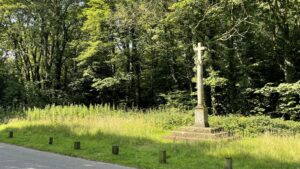
I had a few minutes to kill before a meeting at Ormesby Hall, so I wandered over to the nearby church. There I found the elaborate grave of one Elizabeth Caroline Brown (1834–1905), set among the usual Victorian gravestones.1Historic England. List Entry Number: 1139630. BROWN MONUMENT. https://historicengland.org.uk/listing/the-list/list-entry/1139630?section=official-list-entry2Cleveland and Teesside Local History Society. Ormesby. http://ctlhs.co.uk/golden-jubilee/fifty-interesting-places/ormesby/#:~:text=Elizabeth%20Caroline%20Brown%20(1834%2D1905)%20A%20local%20benefactress%20who%20paid%20for%20the%20school%2C%20the%20church%20tower%2C%20and%20a%20wing%20of%20North%20Ormesby%20Hospital. On Church Lane, not far away, stood a stone cross, neglected and rather out of place. It had replaced a lamp erected in 1896 to mark Queen Victoria’s Diamond Jubilee.3Historic England. List Entry Number: 1159623. QUEEN VICTORIA JUBILEE MEMORIAL. https://historicengland.org.uk/listing/the-list/list-entry/1159623 That lamp had been put up by Miss Brown herself but was damaged when the memorial was later shifted. The cross was installed in its place in 1967.4Elizabeth Caroline Brown Lamp / Cross, Ormesby. Hidden Teesside. https://www.hidden-teesside.co.uk/2011/11/21/elizabeth-caroline-brown-lamp-cross-ormesby/ All very civic-minded. But who exactly was this Elizabeth Caroline Brown?
She remains something of a mystery. A wealthy spinster, owner of 17,000 acres in Ormesby Parish, including a farm called, of all things, “Cold Knuckles” in Cargo Fleet.5A Yorkshire Intinary — Cargo Fleet. Leeds Mercury – 15 July 1905. https://www.britishnewspaperarchive.co.uk/viewer/bl/0000747/19050715/381/0019 She had a grand house in Ormesby and another in Bayswater. When she died on 9 February 1905, she left an estate worth £231,531—a serious sum at the time. Her will, made four years earlier, was executed by Thomas Rawle and William Henry Wood.6WILLS AND BEQUESTS. Illustrated London News – 29 April 1905 https://www.britishnewspaperarchive.co.uk/viewer/bl/0001578/19050429/077/0027 There were the usual charitable donations, though hers were rather more generous than most:
- £4,000 to Ormesby Cottage Hospital
- £3,000 to Ormesby Church for a new tower and spire in a 14th-century style7MINNIE C. HORTON. THE STORY OF CLEVELAND History, anecdote and legend. Page 309. CLEVELAND COUNTY LIBRARIES. 1979
- £2,000 to North Riding Infirmary, Middlesbrough
- £500 each to ten charitable institutions, including Dr Barnardo’s Homes, the RSPCA, and the Lifeboat Institution
Among the personal bequests:
- Ormesby House was left to one John Wood, a mining engineer
- Her Bayswater house, its contents, her bank balance, and a £500 annual annuity went to her maid, Elizabeth Bunting, so long as she remained unmarried
- Several friends and servants received smaller legacies
The rest of the estate was carved up in a manner both precise and faintly absurd: Rawle and Wood each received two-eighths, while four others—Charles Haselton Gilbert, Lady Russell, Laura Dumaresq, and George William Fox—took an eighth apiece.
John Wood, however, was not satisfied, or maybe he was just naive. Two years later, he dragged the whole matter into Chancery.8MINING ENGINEER’S ACTION IN THE CHANCERY COURT. Stockton Herald, South Durham and Cleveland Advertiser – 27 April 1907 https://www.britishnewspaperarchive.co.uk/viewer/bl/0002976/19070427/103/0004 It seems he had signed a deed without grasping that Ormesby House came with seven adjoining fields once used by Miss Brown for rabbit breeding. He claimed he had not realised these fields were part of her occupied estate. Somehow, he signed away his claim to them, then tried to reverse the whole thing in court, demanding the fields and any profits made from them. Whether he succeeded is another matter. One suspects Miss Brown would not have been amused.
- 1Historic England. List Entry Number: 1139630. BROWN MONUMENT. https://historicengland.org.uk/listing/the-list/list-entry/1139630?section=official-list-entry
- 2Cleveland and Teesside Local History Society. Ormesby. http://ctlhs.co.uk/golden-jubilee/fifty-interesting-places/ormesby/#:~:text=Elizabeth%20Caroline%20Brown%20(1834%2D1905)%20A%20local%20benefactress%20who%20paid%20for%20the%20school%2C%20the%20church%20tower%2C%20and%20a%20wing%20of%20North%20Ormesby%20Hospital.
- 3Historic England. List Entry Number: 1159623. QUEEN VICTORIA JUBILEE MEMORIAL. https://historicengland.org.uk/listing/the-list/list-entry/1159623
- 4Elizabeth Caroline Brown Lamp / Cross, Ormesby. Hidden Teesside. https://www.hidden-teesside.co.uk/2011/11/21/elizabeth-caroline-brown-lamp-cross-ormesby/
- 5A Yorkshire Intinary — Cargo Fleet. Leeds Mercury – 15 July 1905. https://www.britishnewspaperarchive.co.uk/viewer/bl/0000747/19050715/381/0019
- 6WILLS AND BEQUESTS. Illustrated London News – 29 April 1905 https://www.britishnewspaperarchive.co.uk/viewer/bl/0001578/19050429/077/0027
- 7MINNIE C. HORTON. THE STORY OF CLEVELAND History, anecdote and legend. Page 309. CLEVELAND COUNTY LIBRARIES. 1979
- 8MINING ENGINEER’S ACTION IN THE CHANCERY COURT. Stockton Herald, South Durham and Cleveland Advertiser – 27 April 1907 https://www.britishnewspaperarchive.co.uk/viewer/bl/0002976/19070427/103/0004

Leave a Reply